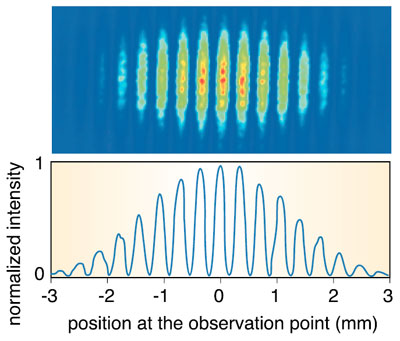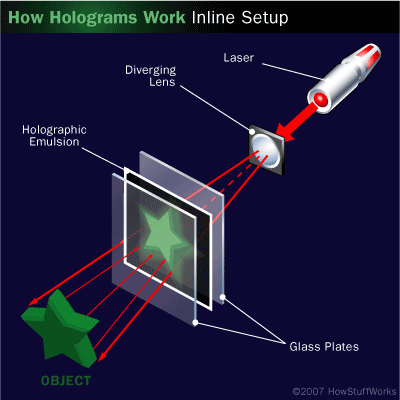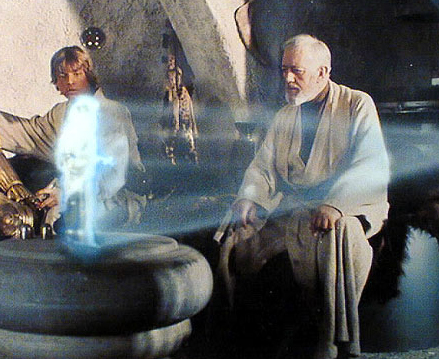Note: I'm on vacation this week, so here's one from the vault. This article first appeared on my old website, back in February of 2009.
Some days the questions I get are easy, and some days I get questions from our longtime reader, Ben. This past week, there have been reports all over the news that our world may be a giant hologram. Let's take a look at what's going on.

In Hanover, Germany, there's an experiment called GEO600. These are two perpendicular lasers, and they shoot out for thousands of feet, get reflected, and come back to their original location to make an interference pattern.

Now the reason this is important is because gravitational waves cause ripples in space in a certain way. These perpendicular lasers are particularly sensitive to what gravitational waves do, and the interference pattern will shift in a very particular way if gravitational waves pass through them. This is the same idea that's behind the upcoming LISA mission.

Now, GEO600, like every laser interferometer we've ever built, has not seen any evidence for gravitational waves. But it has seen something that it can't explain, and that's always interesting for an experiment.
It found some extra noise, above and beyond what can be predicted/explained by things like the vibrations of the Earth, temperature fluctuations, or instrumental noise. What does this look like? Whenever you do your experiment, you do your best to understand what noise you expect to see, and then you look for deviations from this. GEO600 saw something like this:

So there are two possibilities now: either there's a source of noise they haven't figured out, or something physically interesting and novel is causing this. Now, historically, whenever experiments are done, it's almost always unexpected noise that causes something like this to happen. But once in awhile, there really is a new effect that we have going on.
It's very important to state, clearly and unambiguously, before we go any further, that this may simply turn out to be noise. This may not be a physical effect at all, and that no other similar experiments (such as LIGO) see these effects.
But if it is a physical effect, Craig Hogan of Fermilab has come up with an extremely interesting possible explanation. He says that this excess noise could be a sign that our Universe has an extra dimension to it. How does this work? Let's think of a hologram:

A hologram has all the information you could ever want about the dimensions of a 3-D object, but it has it all in two dimensions. For instance, you could tell some object's (or someone's) length, width, and depth just from looking at a 2-D hologram. All of the information is encoded in there.

Well, our Universe may be the same exact way. We know about our 3 space dimensions and our 1 time dimension. But we may have more dimensions of space than we know about; many interesting theories have them. One possible consequence is that these extra dimensions could cause extra "blurring" of our 3 regular space dimensions at very small lengths.

Now, this is very interesting, because the noise we see in the GEO600 experiment causes the laser light to blur on scales of about 10-16 meters and below. This is smaller than the size of a single proton, but amazingly, our technology is sensitive enough that we can detect it! But is this blurring due to extra dimensions? Let's see what the people connected with the experiment say about Craig Hogan's idea:
However Danzmann is cautious about Hogan's proposal and believes more theoretical work needs to be done. "It's intriguing," he says. "But it's not really a theory yet, more just an idea." Like many others, Danzmann agrees it is too early to make any definitive claims. "Let's wait and see," he says. "We think it's at least a year too early to get excited."So it looks like this is worth further investigation, but it's way too early to draw any definitive conclusions. But it's a possibility, and for something as grand as this, for something that would forever change the way we view our Universe, I think it's worth investigating further, and so does the entire GEO600 team.
The longer the puzzle remains, however, the stronger the motivation becomes to build a dedicated instrument to probe holographic noise. John Cramer of the University of Washington in Seattle agrees. It was a "lucky accident" that Hogan's predictions could be connected to the GEO600 experiment, he says. "It seems clear that much better experimental investigations could be mounted if they were focused specifically on the measurement and characterisation of holographic noise and related phenomena."
What do you think?




Comments
I think you should read this
Posted by: Bee | March 24, 2010 2:33 AM
I think "giant hologram" is a really misleading attempt to convey the real ideas; but since most people are so math-phobic, it's the best you can do.
It's really just a higher-dimensional version of what happens when solving the harmonic equation on the complex unit disk: certain differential equations in certain spaces are equivalent to related differential equations on the boundaries.
Posted by: John Armstrong | March 24, 2010 3:47 AM
Interesting. String Theory postulates up to 11 dimensions. If these results end up being more real than imagined, they could go a long way toward becoming an experimental test for the validity of String Theory.
Posted by: Mike Petersen | March 24, 2010 6:44 AM
I think explaining why LIGO does not see the effect would be very important.
Posted by: gski | March 24, 2010 6:46 AM
I think it's probably noise, as you say, but it would be exciting to get some other experiments with different detectors out there looking for the same signal. A question, though, for the physicists out there: are the results of one experiment (like GEO600) enough to motivate theoretical work, or do you need something more robust?
Posted by: DonE | March 24, 2010 8:59 AM
Is this connected to (or the same) as the holographic principle?
Posted by: Nick | March 24, 2010 10:31 AM
Awesome. Didn't realize you had already written about this.
Very interesting stuff.
Posted by: Caleb Fennell | March 24, 2010 1:28 PM
Stop talking about extra dimensions. I don't have the math to handle it and trying to visualize it makes my brain hurt.
Posted by: the backpacker | March 25, 2010 10:35 AM
I know of spacial and time dimensions, but what other dimensions are there?
Posted by: crd2 | March 25, 2010 12:28 PM
If you don't mind a stupid question; What would you get if you added a third laser firing at ninety degrees to the first two? A bore hole sounds easier than thousand foot tall tower so we'll go with that.
How would you depict the information? Would results change? Would you get results? Or would you just end up with random noise? Would it add anything or just confuse the issue?
Posted by: Art | March 25, 2010 2:10 PM